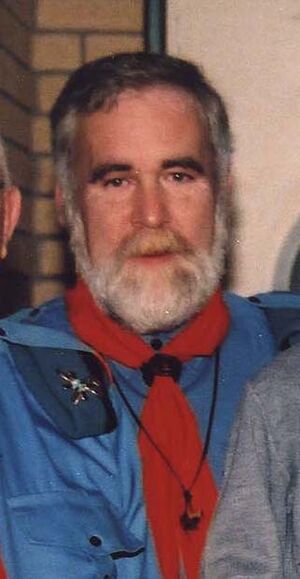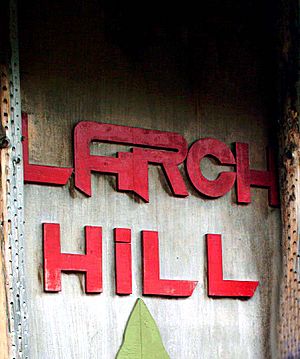Larch Hill facts for kids
Quick facts for kids Larch Hill |
|||
|---|---|---|---|
 |
|||
| Owner | Scouting Ireland | ||
| Location | Tibradden, Dublin | ||
| Country | Ireland | ||
| Coordinates | 53°15′14″N 6°16′54″W / 53.253885°N 6.281766°W | ||
| Founded | 1938 | ||
| Founder | Prof. JB Whelehan | ||
| Center manager | Conor McKeown | ||
|
|
|||
| Website http://www.larchhill.org |
|||
Larch Hill International Scout and Guide Centre is a special place for Scouts and Guides in Ireland. It's the main campsite and also where Scouting Ireland has its offices and training facilities. It's a big hub for Scouting activities!
Contents
What is Larch Hill?
Larch Hill was bought in 1937. Since then, it has become one of the most important places for Scout camping in Europe. The site has been greatly improved since Scouting Ireland was formed in 2004.
The main building at Larch Hill is very unique. The whole site is 226 meters (about 740 feet) above sea level. It has many areas for camping, a small hostel, and rooms for meetings. You can also find hiking trails, a nature center, and a playground for younger Scouts. There's even a big campfire circle for singing and stories!
Larch Hill got its name because people believe it was the first place in Ireland where the European Larch tree was planted.
The people who help run the site are called the Meitheal. They are volunteers from Scouting Ireland. They wear a special orange neckerchief with the Larch symbol.
Larch Hill's Story
Larch Hill has been home to many different people over hundreds of years. The first known person to live there was a 'Mr. Smith' in 1801.
The oldest buildings still standing were built as a summer house. A rich merchant from Dublin, John O'Neill, used it around 1821. He was a kind person who helped build a church and supported a school for poor children.
John O'Neill's son sold Larch Hill in 1845. Another wealthy businessman, Courtney Kenny Clarke, owned it later. He might have owned one of the many paper mills nearby. In those days, the area was famous for its fine paper.
From 1914 to 1918, during the First World War, Larch Hill was used as a place for soldiers to recover.
Before the Scouts bought it, a Dublin businessman named John Coffey owned the estate. He faced money problems, and the bank took over the property.
Scouting at Larch Hill
In 1937, Professor J.B. Whelehan, who was the Chief Scout at the time, decided to buy a campsite. They looked at a few places, but Larch Hill was chosen. Professor Whelehan believed Larch Hill would stay a natural, outdoor place longer than other options.
The money to buy Larch Hill came from a trip to Rome in 1934. The Scouts made a profit from non-Scout tickets on this trip. They also received a donation from the Knights of Saint Columbanus.
Larch Hill officially opened as a campsite on June 4, 1938. Over 400 Scouts from Dublin attended the first camp that weekend.
The Meitheal team has also run many Cub and Scout summer camps. These were like small jamborees. For example, "Camp Millennium" in 1988 celebrated Dublin's 1,000th birthday. "Hill 96" had over 1,200 young people!
Exploring Larch Hill's Layout
Camping Fields
Larch Hill has many different camping fields, each with its own story:
- Taylor's Field is named after John Taylor. He was the first warden (manager) of Larch Hill from the late 1940s to the mid-1950s.
- Potato Field gets its name from old ridges in the ground. These are "lazy beds" where potatoes were once grown.
- Melvin Field is named after the Melvin trophy. This was a national competition for Scouts. The money from the trip to Rome that helped buy Larch Hill came from Sir Martin Melvin.
- The Training Field was where many early leader training courses took place. In the past, a special group of leaders called the 1st Larch Hill troop used this field. They helped teach other leaders about Scouting methods.
- The Haggard Field is an old Irish name for a small area used to store food for animals. It's surrounded by stone walls.
- The Upper and Lower Dolmen Field are named after an ancient tomb found there.
- The Triangle Field is simply called that because of its shape!
- The Cub Field is a large, flat area. This makes it perfect for younger Scouts and Cub-Scouts to set up camp.
- Kelly's Field is named after Kelly's Glen, a nearby valley.
- The Crow's Nest is surrounded by tall trees. These trees are perfect for crows to build their nests.
The Garden Area
The garden area is about 1 acre (4,000 square meters) in size. It has many interesting and unusual trees, like the Monkey Puzzle tree. It reminds people of the beautiful walled gardens found on large estates in the 1800s.
Other Cool Features
The current car park used to be the stable and farmyard in the 1800s. You can still see parts of the old buildings near the toilets.
The Mass Lawn area was once a tennis court. The altar on the Mass Lawn is made from the granite steps of the original house. That house was taken down in the 1970s when the current hostel was built.
The Ice-House is a bunker-like building on the lower path. It was the old "refrigerator" for the manor house. In winter, ice blocks from the river were stored inside with food. This kept the food cold all summer!
The dolmen (or cromlech) is an ancient tomb made of large stones. It's one of three in the area. A dolmen was a royal burial spot. It has two upright granite blocks supporting a third one across the top. Locals sometimes call it "the druids altar." It's also linked to an old battle from 916 AD.
Larch Hill also has two Adirondack shelters you can rent. These shelters sleep 8 people each. They are great for backwoods camping or as a stop on a hike. Larch Hill is close to the Dublin Mountain Way and the Wicklow Way hiking trails.
River and Swimming Spots
The River Glin flows through Larch Hill. It comes from a valley called Kelly's Glen. In the 1800s, people would visit a spa in the glen because they believed the water had special minerals.
A swimming pool was built on the River Glin at the lower end of the estate. It was used for many years, but it is not in use today.
Near the entrance to the Crow's Nest field, there's a big dip in the ground. This is where Scouts tried to build a swimming pool a long time ago in the 1940s. It didn't work out, so it's known as "Matthews's Folly."
Animals and Traditions at Larch Hill
Many animals live on the large Larch Hill estate. You might spot badgers, squirrels, and even deer.
The Whit weekend is a very busy time at Larch Hill. Scouts from Dublin and nearby areas often visit, almost like a special trip to the national campsite.
The bookmaker John Coffey, who owned the site before the Scouts, kept racehorses there. His most famous horse was "Fast Pam." People believe "Fast Pam" is buried near the campfire circle.
Larch Hill in the 21st Century
Larch Hill, often called "The Hill," has changed a lot recently. A new pyramid-shaped building was built. It houses the permanent staff of Scouting Ireland. This building has brought new energy to the campsite.
The glass building also has a large meeting room called the Millennium Room. It's used for meetings for Scouts and leaders. Inside, you can find a statue of Fr. Tom Farrell, who founded the Catholic Boy Scouts of Ireland. There's also a museum with badges and souvenirs from World Scout Jamborees.
The Meitheal team works hard to keep the campsite in great shape. Every weekend, campers from all over Ireland and Europe come to visit. In 2002, Larch Hill hosted one of four national camps to celebrate the 75th year of Scouting Ireland (CSI). It also hosts important meetings for Scouts, Venture Scouts, and Rover Scouts every year.
Larch Hill will host the 16th World Scout Moot in summer 2021. This is a huge international event for young adult Scouts!
Fun Activities at Larch Hill
There are many exciting activities you can do at Larch Hill! These include orienteering (using a map and compass), hiking, archery, a high ropes course, and a zip line. The large estate is perfect for hiking adventures.
The Tree Council of Ireland has created a booklet called the "Larch Hill Tree Trail." This booklet describes 25 different types of trees found at the campsite. These include the main trees like the Larch, Sequoia, and Sitka spruce. Following the "Tree Trail" takes you all around the site, visiting each camping field.
Larch Hill is also close to the Dublin Mountains and the Wicklow Mountains. This gives Scouts the chance to explore some of Ireland's most beautiful hiking routes. You can visit places like the Wicklow Way and the old monastery of St. Kevin at Glendalough.
The large forest areas are great for bivouacking (camping outdoors with minimal shelter) in the summer. Different parts of the forest have different types of trees. Some areas have Norway Spruce trees, while others have strong Sycamores, Elms, and Larches. These trees provide good shelter for survival camping.
Local Scout Connections
Many local Scout Groups have helped build and develop Larch Hill over the years. For example, the 13th Dublin Group gave Larch Hill its first motorized transport, a truck. They also helped widen and dam the stream to create a swimming pool. This pool was built over several years in the 1950s and 1960s. By 1963, a pool 50 feet (15 meters) by 24 feet (7 meters) was finished. You can see old photos of the working pool at the 13th Dublin's den.




